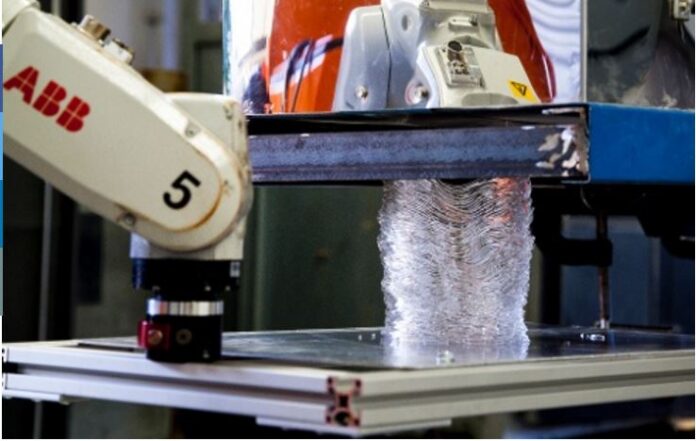
Artists, designers, architects, and industry members are exploring concepts in glass design through the nation’s first Collaborative Glass Robotics Laboratory, an initiative of Virginia Tech and the Rhode Island School of Design.
Formed in 2013 and about to expand, the Glass Robotics Lab is an initiative of Nathan King, an assistant professor of architecture and steward of the Design Technology Initiative in the Center for Design Research at the Virginia Tech School of Architecture + Design, and Stefanie Pender, a glass artist and faculty member in the Glass Program at the Rhode Island School of Design.
Already, the lab has demonstrated robotic glass blowing, robotically actuated molds, and robot-based 3-D printing for glass.
“The 6-axis glass-printing process was proven in 2013 and has continued to improve. At this point glass printing has caught the attention of several research groups, each making incremental strides, and each with different goals,” King said. “The glass robotics facility is the first of its kind research studio and will house a large custom glass furnace, large format annealing ovens, and will utilize the Design Robotics Studio’s large format industrial robotic arm to support the advancement of the mission to realize new potential in glass through the lens of computational design and digital fabrication processes.”
The large format glass studio will open in the spring at the College of Architecture and Urban Studies’ Research and Demonstration Facility in Blacksburg.
Customization through computational design is an innovative territory for glass fabrication that has vast possibilities in integrated systems and the crafting of customized, high-performance objects, the researchers said.
“This research is an example of innovation that can occur at the intersection of art, design, technology, and science,” Pender said. “Instead of a technology-driven approach, we can approach digital fabrication from a place of profound material understanding. This research is evidence that the traditional technical arts will not be replaced by digital fabrication, instead, the technical arts will help to drive and support the direction of future making.”
The robotic method developed by the Glass Robotics Laboratory is primarily geared toward pushing the boundaries of material exploration and strategic process intervention.
Presently, the field places emphasis on exact precision and utmost material control governed by the prescribed computational form and surface finish. The Glass Robotics Laboratory has a different approach whereby the process embraces the intrinsic qualities of glass, such as self organization, that result in emergent patterns and new design opportunities. “Beyond material exploration we are also developing new digital processes that allow real-time robotic motion control thus enhancing the potential to exploit a range of material behavior,” King said.
“By focusing on the integration of the material and the computational, we can discover generative behaviors within the glass material,” Pender said. “For example, ‘transient coiling’ is a mode of movement which hot glass fibers rotate as they come into contact with other materials, thus creating volumetric depth from simple planar movements. The ability to highly control the movement of the glass as it is deposited through robotic control reveals an opportunity to manipulate this phenomenon which would be impossible without an automated process — thus presenting a new design potential.”
The Glass Robotics Laboratory operates with the support of the Division of Foundation Studies and the department of Glass at Rhode Island School of Design; the Virginia Tech School of Architecture + Design, Center for Design Research; and has received funding from the RISD2050 program; the Virginia Tech Institute for Creativity, Arts, and Technology; and Autodesk.


